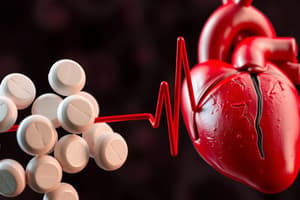Podcast
Questions and Answers
What medications are included in Class 1a?
What medications are included in Class 1a?
- Flecainide
- Lidocaine, Mexiletine, Phenytoin
- Sotalol
- Quinidine, Procainamide (correct)
Which of the following is in Class 1b?
Which of the following is in Class 1b?
- Lidocaine (correct)
- Procainamide
- Flecainide
- Quinidine
What is the mechanism of action of Class 1a antiarrhythmics?
What is the mechanism of action of Class 1a antiarrhythmics?
- Block K+ channels (correct)
- Inhibit Ca2+ channels
- Block Na+ channels (correct)
- Agonize β-receptors
What is an example of a Class 1c antiarrhythmic drug?
What is an example of a Class 1c antiarrhythmic drug?
What are the cardiovascular actions of Quinidine?
What are the cardiovascular actions of Quinidine?
Which of the following is a side effect of Quinidine?
Which of the following is a side effect of Quinidine?
Procainamide is used for what purpose?
Procainamide is used for what purpose?
Lidocaine has a significant effect on normal heart conduction.
Lidocaine has a significant effect on normal heart conduction.
What is a contraindication for using Quinidine?
What is a contraindication for using Quinidine?
What drug class does Liodocaine belong to?
What drug class does Liodocaine belong to?
Flashcards are hidden until you start studying
Study Notes
Class 1 Antiarrhythmic Drugs
-
Class 1a includes Quinidine and Procainamide; they block Na+ channels and cause moderate decrease in slope of phase 0, prolonging repolarization and increasing action potential duration (APD) and effective refractory period (ERP).
-
Class 1b consists of Lidocaine, Mexiletine, and Phenytoin; these drugs block Na+ channels with minimal effect on the slope of phase 0 and shorten repolarization in normal fibers.
-
Class 1c is represented by Flecainide, which marks a significant increase in the slope of phase 0 with little impact on repolarization.
Quinidine Mechanism of Action (MOA)
-
Quinidine primarily blocks activated Na+ channels, with less effect on inactivated channels, K+ channels, and Ca2+ channels at high doses.
-
It also interacts with α1 adrenoceptors and muscarinic acetylcholine receptors, leading to decreased conduction and increased refractoriness due to K+ channel blockade.
Quinidine Cardiovascular Actions
-
Minimal change in heart rate due to balancing effects of direct action and antimuscarinic activity.
-
Variable impacts on atrioventricular (AV) conduction, with a reduction in intraventricular conduction and cardiac contractility at elevated doses due to Ca2+ channel blocking.
-
Causes vasodilation at high doses through α-blocking effects.
Quinidine Indications
-
Rarely used now due to safer alternatives. Indicated as a second-line agent for ventricular ectopic beats, atrial flutter, atrial fibrillation, recurrent supraventricular tachycardias, and ventricular tachycardias.
-
Other applications include treating severe falciparum malaria and nocturnal leg muscle cramps.
Quinidine Adverse Effects (AE)
-
Risk of various arrhythmias or asystole due to SA node depression and decreased conduction attributed to hyperkalemia.
-
Potential for Torsade de Pointes, syncope, or sudden death from asystole or ventricular tachycardia.
-
Digitalis toxicity in patients on digoxin, blurred vision, hallucinations, and gastrointestinal symptoms such as diarrhea can occur.
-
Sodium lactate is the preferred treatment for quinidine overdose, enhancing Na+ current and reducing drug receptor binding.
Quinidine Contraindications (CI)
- Should not be used in cardiac failure, digoxin-induced arrhythmias, myasthenia gravis, or thrombocytopenic purpura.
Procainamide Properties
-
Oral bioavailability is about 75%, with 25% biotransformed into the active metabolite N-acetylprocainamide, which varies genetically among individuals.
-
About 75% of Procainamide is excreted unmodified by the kidneys, making renal function important in its use.
Procainamide Mechanism of Action
- Similar to Quinidine, blocking activated Na+ channels with less prominent antimuscarinic activity and no effects on Ca2+ channels or α-adrenoceptors.
Procainamide Adverse Effects
- Similar cardiac risks and gastrointestinal side effects as Quinidine, in addition to a lupus-like syndrome.
Procainamide Indications
- Used for acute treatment of specific arrhythmias such as those associated with Wolff-Parkinson-White syndrome, and when other arrhythmia treatments are ineffective or poorly tolerated.
Lidocaine Properties
- Class Ib antiarrhythmic focusing on the blockade of activated and inactivated Na+ channels.
Lidocaine Electrophysiological Actions
-
Leads to slight decrease in conduction and reduced refractoriness in normal cells while increasing refractoriness in depolarized cells.
-
Particularly effective against arrhythmias linked to depolarization, but less effective in normally polarized tissues.
Lidocaine Cardiovascular Effects
- Causes mild decrease in contractility and heart rate at high doses, alongside vasodilation.
Lidocaine Adverse Effects
- Considered the least cardiotoxic antiarrhythmic, but can still lead to adverse cardiac outcomes and neurological symptoms.
Studying That Suits You
Use AI to generate personalized quizzes and flashcards to suit your learning preferences.




